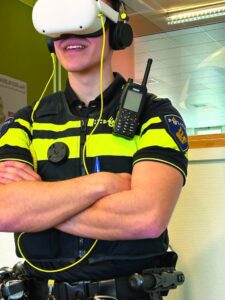The reality and perception of biased policing is a significant issue facing law enforcement leaders, not only in the United States but in many countries around the world. Policing based on stereotypes and biases can make police ineffective, unsafe, and unjust. Perceptions of biased policing can have a huge negative impact on the relationship between police agencies and the diverse communities that they serve. For instance, in the summer of this year, France experienced violent riots linked to perceptions that the police act in a biased manner when interacting with marginalized communities.
The modern science of bias indicates that the executives of even the best agencies have to provide leadership on this issue, and providing implicit bias training (IBT) is one important aspect of an agency’s comprehensive efforts to produce impartial policing and prevent the perceptions of bias. The provision of this training in law enforcement is a relatively new development based on a revolution in the research on bias and prejudice that disabused experts of the notion that all bias is conscious and all discriminatory behavior is intentional. Social psychologists discovered that even well-intentioned individuals who reject prejudice and stereotypes at the conscious level have implicit biases that can affect their perceptions and behavior, sometimes outside of conscious awareness. The purpose of IBT is to educate the participants about the modern science of bias, highlight how human bias might affect their own behaviors, and give them the motivation and skills they need to produce impartial behavior.
Implicit bias training has been adopted around the world, not only in law enforcement, but also in a number of other fields (e.g., education, medicine). The evaluation research shows that IBT can be effective. In general, experimental evaluations show that people who are randomly assigned to receive IBT, compared to their control group colleagues, demonstrate the following qualities:
- Increased awareness of bias and concern about discrimination1
- Increased motivation to behave in a bias-free manner2
- Intention to use bias-managing techniques3
Importantly, research has documented changes in behavior linked to implicit bias training, including reductions in biased behavior.
In reviewing the evaluation research to date, however, it is important to keep in mind that not all implicit bias training programs are created equal. The quality and sophistication of training ranges from generic online courses to the program of the Dutch Police (developed by the coauthor of this article, Captain Bas Böing), which uses virtual reality (VR) simulations to help officers recognize biases that might affect their behavior. That training outcomes will vary depending on the nature and quality of a program is predicted by science (i.e., research in the realms of implicit bias and effective learning) and highlighted in an article that appeared in Harvard Business Review (HBR) entitled “Unconscious Bias Training that Works.” The science and that article point to the aspects of IBT that can increase the likelihood of success.
Reducing Defensiveness
The HBR article references the importance of overcoming denial, which is especially relevant to law enforcement audiences. Many trainees will enter a session on “biased policing” with a high level of defensiveness or even hostility. This resistance is understandable, in light of the decades of accusations of racist policing, but if it is not reduced, officers could reject the entire course as patronizing or even insulting. This defensiveness can be reduced with appropriate course content and effective trainers. Content can reduce defensiveness by conveying the message (confirmed by a voluminous body of research) that well-intentioned individuals in every profession have biases that can affect perceptions and behavior.
Defensiveness can also be reduced by high-quality trainers. Trainers who are current or recently retired law enforcement bring credibility to the training session and can personally attest to how policing based on biases can be detrimental to safe and effective policing.
Providing Motivation to Engage and Learn
Reducing defensiveness is necessary but not sufficient. A large body of literature shows that positive attitudes are crucial for producing change, so implicit bias training programs need to motivate the participants to engage in the training and adopt the skills with which they are presented.7 Training programs can motivate trainees with engaging methods. The VR of the Dutch model is attractive to officers who are eager to try the technology. Another method, Fair and Impartial Policing (FIP) (developed by the coauthor Dr. Lorie A. Fridell) promotes engagement with small- and large-group discussions, application exercises, written and video scenarios, polling, and other techniques.
A training program can motivate trainees by showing that the content has relevance for their work. It should present real-world, police-specific examples and focus not on the most egregious examples of biased policing but on the day-to-day decisions of law enforcement officers that could be affected by their human biases. The training developed by the Dutch Police uses VR to place officers into 360-degree realistic urban environments. In one scenario, there are multiple community members in the scene and the officers are directed to identify and intervene with the person or people “worthy of investigation.” The participants (working in pairs) make their choice and then make additional decisions about how to engage with the community members; these choices are supported by branching scenarios. Afterward, the trainees are asked to discuss the reasoning for their choices in light of the organization’s stop and search policy.
FIP participants are exposed to studies that document common societal stereotypes associated with the various types of people with whom police interact (e.g., people who are experiencing homelessness) and generate their own examples of stereotypes or “implicit associations” in small- and large-group discussions. Similarly, after learning about the key characteristics of implicit bias, the trainees identify the types of police activities that might be most at risk of biased decision-making (e.g., situations characterized by ambiguous information, such as “investigating suspicious persons”). To further highlight the relevance of the content, the FIP law enforcement trainers share examples of incidents in their own careers where they acted on their biases, producing a safe environment for participants to reflect on their own prior decisions and behaviors.
Motivation to engage in the training and adopt the skills is also produced by conveying the value of impartial policing or, conversely, the consequences of biased policing. FIP uses powerful, real-life examples (based on actual incidents) to show that law enforcement actions based on biases or stereotypes can make police ineffective, unsafe, and unjust. The Dutch scenarios, too, provide opportunities for officers to see themselves or others acting in a biased fashion and the consequences of it (e.g., not identifying the true culprit).
Training Skills
The HBR article highlights the importance of providing trainees with skills for addressing their biases, and implicit bias research literature identifies those that are most effective.
There is some confusion regarding the types of skills that have the most promise. The social psychologists studying “debiasing techniques” distinguish between techniques for reducing bias versus managing bias. This is an important distinction and one that is missed by some journalists seeking to disparage implicit bias training. These journalists criticize IBT by pointing to research that documents that many “debiasing techniques” do not reduce a person’s level of biases. They are right about the science—but misunderstand the purpose of IBT. It is not the goal of implicit bias training to reduce a person’s bias. IBT programs that are based on the science may share some of the more effective (long-term) bias-reducing skills (e.g., having positive contact with diverse groups), but most emphasis should be given to bias-managing skills. That is, trainees should learn techniques for recognizing and managing their biases so that those biases do not impact their behavior.
Skills for producing impartial policing are not the same for all levels of a department. For instance, in the FIP program, line-level personnel learn to (1) recognize and manage their biases, (2) slow things down when feasible, (3) be aware of the biases of others (i.e., community members and colleagues), and (4) apply their agencies’ impartial policing policy. Supervisors learn all of those skills and are also trained to “supervise to promote impartial policing.” Command-level personnel learn all of the preceding skill sets and receive guidance in how to implement a comprehensive strategy to promote impartial policing. Elements within that strategy include recruitment and hiring, policy, training, leadership, accountability, measurement, operations, and outreach to diverse communities.
Applying Adult Learning Concepts
The most effective implicit bias training will be based on adult learning concepts. Adult learning theory promotes the involvement of participants in their own learning and each other’s learning. As previously noted, the program of the Dutch police includes a full group discussion after the officers have completed the VR scenario. Officers explain the choices that they made and hear from other officers who made different decisions. This discussion allows the officers to reflect on their own decisions and can serve to stimulate their awareness of how human biases could affect their day-to-day activities.
Consistent with adult learning theory and research, IBT training cannot be a one-off experience. First, police leaders in an agency—from the sergeant to the chief—must reinforce the messages of IBT after personnel are trained. Second, as with any important (especially high liability) policing topic, “booster training” is required. This need is reinforced by the evaluation research indicating that positive outcomes linked to IBT diminish over time.10 The training that comes 12 to 18 months after the first training should reinforce and build on the content of the original training, but in a new and fresh manner. The key objectives of FIP’s booster training are to review and update the science of bias, rejuvenate the officers’ motivation to use their bias management skills, and review (and practice) those skills. With video vignettes, participants are placed into the shoes of officers engaged in common, real-world situations. These video scenarios stop at various points in the encounters, and the class is directed to make a choice about what they should do next. Whatever choice the participants make is linked to a key concept in the science of bias and the skills they need to use to produce impartial policing.
Conclusion
Law enforcement personnel around the world have been trained on the general topic of biased policing or racial profiling for decades. Much of that training was based on the “old science,” which recognized only conscious biases that are based on animus toward groups and that produce intentional discriminatory behavior. These explicit biases still exist in society and there are still racist individuals in policing and, indeed, in all professions. But the widespread adoption of IBT reflects the fact that most officers are well-intentioned individuals who want to police in an unbiased fashion. This type of training helps them do just that. And while the evaluation research indicates that implicit bias training can positively impact knowledge, attitudes, and behavior, there are two important caveats. First, there is much variation in versions of implicit bias training, and some, according to research, have more prospects for change than others. Effective programs include the important elements discussed herein. Second, and even more important, no one should assume that IBT is the silver bullet for addressing the issue of biased policing. IBT can help well-intentioned officers recognize their biases and implement skills for managing them; it will not cure a racist officer of their animus toward marginalized groups. Related to this, and as highlighted in the HBR article and elsewhere, IBT for police is not “the answer” to the problem, but rather a necessary component of multidimensional efforts to promote impartial policing. To be most effective, IBT must be integrated into broader reform efforts.
Lorie Fridell, PhD, is an emeritus professor in the Department of Criminology at the University of South Florida. Her research interests include police use of force, police deviance, bias in policing, and violence against police.
Captain B.S. (Bas) Böing, MSc, is a police captain, program lead for the Dutch National Police, and a PhD candidate at the University of Twente.




